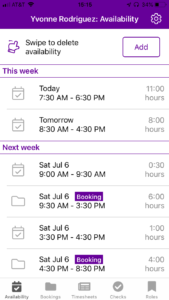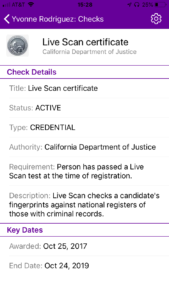[ezcol_2third]
 This section contains User feedback, Business and Technical Specifications relating to the CEDAH software. Documents on this page are part of the deliverables for our work within the Kauffman Foundation Challenge. They cover system changes ahead of US launch plus project management reports from 2020.
This section contains User feedback, Business and Technical Specifications relating to the CEDAH software. Documents on this page are part of the deliverables for our work within the Kauffman Foundation Challenge. They cover system changes ahead of US launch plus project management reports from 2020.
Project management documents
Technology details
Our technology based service is called a CEDAH (Central Database of Available Hours). It can be seen in action towards the end of this project in these videos. Internally, we call the software enabling this system “uFlexi”. This allows us to separate the software from the installed service in our planning.
The system is built in JavaScript. Technical architecture documentation is here with an update, after transfer from UK servers to AWS in the US within this project, here.
We are on course to open source this distinctive technology. We see this as requiring a rebuild of the core system as soon as resources are identified. It has many legacy elements and requires more consistent internal structures and removal of partially superflous blocks of code before being opened to a diverse community of developers. Much has been learned over successive builds; amendments we have planned for a streamlined new version build on that learning.
Scope of the project
Our primary objective ahead of US launch was preparing uFlexi to capture as much data on social outcomes as possible. To do this we had to:
- Develop a Mobile App: We had been relying on Responsive Design for phone-based interaction with the system. But commercial labor market platforms have developed a range of slick apps that set a standard we needed to recognize. At the end of the project we have a robust worker app on IoS and Android. This opens the service to a wider range of users.
- Improve granularity: This has to start with the building blocks of user progression; the datapoints about competencies, willingness to comply with specific requirements (“work with animals” for example) and categorizations that attract support (“Opportunity Youth” for instance).
- Motivate intermediaries and public agencies: Empowering markets won’t arise commercially, the business model for exploitative practices in for-profit hourly labor markets is too compelling. A worker-centric alternative relies on public bodies using their heft to launch in any area. There then needs to be at least one intermediary who acts as an employer of record. These bodies need detailed controls to preserve their identity, brand and language. They may need specific outcomes reporting to justify their funding. Making uFlexi adaptable to their individual requirements greatly increases their motivation for initiating a market at scale.
- Prepare for Artificial Intelligence: As this project progressed, it became clear – in engagement with users and our own deliberations – how new AI tools could benefit our population. We do not have resources to build these at present, nor are we necessarily the best people to do so. Our function may be more of an enabler for an array of AI offerings that use an API (Application Program Interface) to extract controlled data at a user’s behest. Anticipating this need became part of our planning within the project.
- Facilitate cautious launches: The huge datasets required for a system to identify individualized opportunity paths in any locality have to be achieved incrementally. In talking to potential early buyers of labor it became clear how worrying the prospect of engaging their workforce through a market dedicated to worker progression and exposing them to multiple employers would be. The prospect makes sense when many other employers are doing it, but could upend the labor pool for an early adopter going alone. In response we have been modifying uFlexi for gradual starts, that don’t challenge an employer’s existing business practices apart from allowing workers more control over their hours and access to more hours. For example, we allow pay/charge rate display to be disabled across all functions for an intermediary.
User interaction
 We presented the technology at a variety of user forums around the Los Angeles area and in California, (a list can be provided). We tried to focus on people with deep experience of target groups who could critique from a wide perspective rather than a purely personal response. We also engaged with potential users one-on-one in an attempt to negate any kind of “groupthink”.
We presented the technology at a variety of user forums around the Los Angeles area and in California, (a list can be provided). We tried to focus on people with deep experience of target groups who could critique from a wide perspective rather than a purely personal response. We also engaged with potential users one-on-one in an attempt to negate any kind of “groupthink”.
In parallel, deliverables below document how we worked to address these aims ahead of launch of the CEDAH (Central Database of Available Hours) platform in America.
Deliverables
Our deliverables linked from this page focus on:
- Web interface upgrades
- Accessibility enhancements
- Mobile app
- API planning/build
Within each we have included:
- A narrative account of the issues we prioritized and our reasoning.
- Detailed documentation: this includes business specifications, technical specifications and planning documents. To make this actionable we have tried to extract materials relating to what became the key challenges or possibilities and exclude more routine materials.
Contents of this section:
1) Web interface upgrades
1a) Narrative
1b) Tech. reporting: The timezone issue in complex grid displays
1c) Business spec: Switchable elements
1d) Business spec: Multiple contracts
1f) Tech analysis: Initial analytics
1g) Business spec: Direct Employment Relationships
2) Accessibility
2a) Narrative
2b) Tech spec: User way issues
2c) Position paper: Quality irregular work in the Jobs Data Exchange schema
3) Mobile App
3a) Narrative
3b) Initial training video for the app
-
- We made this video to show an early version of the app to remote users while it was still in a test environment. Multiple screen upgrades have occurred since.
3c) Technical report: Homepage alignment
4) API planning/build
4a) Narrative
4b) Technical report: API build
4c) Planning paper: Readiness for Artificial Intelligence applications
[/ezcol_2third] [ezcol_1third_end][/ezcol_1third_end]
